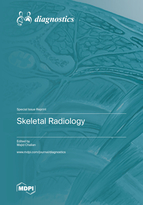Skeletal Radiology
A special issue of Diagnostics (ISSN 2075-4418). This special issue belongs to the section "Medical Imaging and Theranostics".
Deadline for manuscript submissions: closed (31 August 2022) | Viewed by 85923
Special Issue Editor
Interests: radiology; imaging; musculoskeletal radiology
Special Issues, Collections and Topics in MDPI journals
Special Issue Information
Dear Colleagues,
Musculoskeletal disorders are commonly encountered diseases affecting a wide age range of our patients from young athletes to elderly population. Advances in imaging technology with multi-slice CTs, high-frequency ultrasounds, and high-resolution 3T MRIs have revolutionized the diagnosis of these often-subtle structural disorders and provided us with new opportunities for improved patient care. New CT and MRI techniques have made it possible to predict disease processes to diagnose pathologies in the pre-structural phase. This will create the opportunity for early diagnosis and treatment of musculoskeletal disorders.
This field has already changed and will continue changing with novel approaches such as radiomics, machine learning, and quantitative analysis using multiparametric imaging. All these new, emerging diagnostic approaches are advocating the idea of precision and personalized medicine. This Special Issue aims to provide some updates on novel diagnostic approaches for different musculoskeletal disorders.
Dr. Majid Chalian
Guest Editor
Manuscript Submission Information
Manuscripts should be submitted online at www.mdpi.com by registering and logging in to this website. Once you are registered, click here to go to the submission form. Manuscripts can be submitted until the deadline. All submissions that pass pre-check are peer-reviewed. Accepted papers will be published continuously in the journal (as soon as accepted) and will be listed together on the special issue website. Research articles, review articles as well as short communications are invited. For planned papers, a title and short abstract (about 100 words) can be sent to the Editorial Office for announcement on this website.
Submitted manuscripts should not have been published previously, nor be under consideration for publication elsewhere (except conference proceedings papers). All manuscripts are thoroughly refereed through a single-blind peer-review process. A guide for authors and other relevant information for submission of manuscripts is available on the Instructions for Authors page. Diagnostics is an international peer-reviewed open access semimonthly journal published by MDPI.
Please visit the Instructions for Authors page before submitting a manuscript. The Article Processing Charge (APC) for publication in this open access journal is 2600 CHF (Swiss Francs). Submitted papers should be well formatted and use good English. Authors may use MDPI's English editing service prior to publication or during author revisions.
Keywords
- diagnosis
- MRI
- CT
- ultrasound
- artificial intelligence
- musculoskeletal
- joint
- sarcoma
- multiple myeloma







